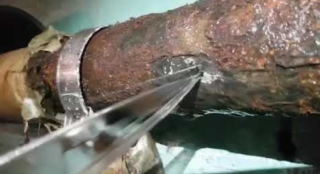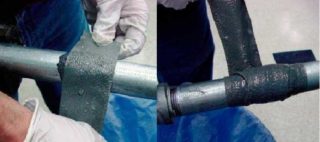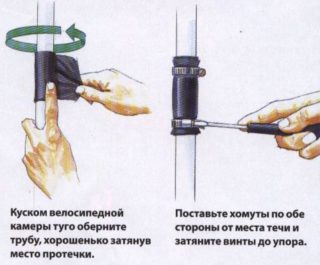Any leak in a pipe is an emergency that must be quickly neutralized regardless of the type of mains used (water supply, heating, etc.). To eliminate leaks in pressurized water pipes at home, it is important to be extremely careful. Especially when it comes to hot water supply. Burns and large flooding are not excluded here. It should be remembered that latka is not a panacea. If there is a hole in the tube, the same fate awaits the highway in its other sections. It is best to change the metal piping to plastic (PP, PVC) as soon as possible. In addition, it is possible to close fistulas on a hot or cold water pipe only when the hole is small. If the liquid gushes like a fountain, no clamps and patches will help.
The main causes of pipeline leaks

Fistula is a pitting corrosion on one of the sections of a metal pipeline. More often, such phenomena are typical for cast iron and steel. Unfortunately, time takes its toll, and rust simply eats away at the metal in places. As a result, water flows through the holes formed, and floods are formed.
The first signs of a future fistula are corrosive growths on the surface of the pipe or paint swollen in these places. The main causes of holes are:
- active effect of rust on the metal from the inside or outside;
- broken line installation technology - joints, welds are especially weak in this regard;
- frequent mechanical impact on the line - strong blows, occasional frequent touches over time lead to depressurization of pipes.
- sharp, frequent abnormal pressure drops in the system.
If you find a build-up of rye on a pipe, do not rush to tear it off. It is not known what size the fistula was hidden under it.
Risk areas
The weakest and most potentially dangerous points in the pipeline are:
- areas of the highway under constant mechanical stress;
- joints of heating radiator sections;
- straight sections of metal lines;
- threaded connection points;
- electric welding zones;
- insertion points for additional branches.
All these points need to be checked regularly, especially if there is a drop in pressure in the system, communication nodes are not working correctly, and there is no visual leak.
All communication must be checked while running. In this case, the fistula helps to identify ordinary toilet paper. It is enough to carry it out in a beam in the most dangerous zones of the pipeline. Moisture on the paper indicates leaks.
The fistula must be repaired / sealed in such a way that the pipe can work out its operational life or that the line lasts until the line is completely replaced.
Effective ways to eliminate leaks in a pressurized water pipe

The main rule is that before you glue the water pipes or the heating line, you need to drain the water through the riser / system. In the absence of a complete drain (or if the riser is not closed), a flood is not excluded due to a possible further rupture. It is possible to properly repair cracks in the heating pipe without draining the water, only if the fistula is very small, and the tubes themselves inspire confidence: the rest of their length remains visually intact, not subject to corrosion.
Medical bandage plus cement mortar
This method is suitable for cast iron and steel pipes that have a fair amount of fistula, but the rest of the line looks visually strong. It is important to take into account that the cement slurry will form an additional load on the tubes. If they are already pretty rusty in many places, you should not risk it this way. Complete line break possible under pressure.
To carry out the work you will need:
- standard medical bandage;
- cement mortar;
- scissors;
- metal brush.
With a brush, gently remove the rust around the fistula. If the metal crumbles, increasing the hole in diameter, you need to remove it too. Next, you need to cut off the pieces of the bandage, dip them into the cement mortar and apply them to the crack in layers from the top and bottom of the pipe. Thus, a kind of cocoon is formed around the leak zone. At the last stage, you need to cover the bandage well on top with a layer of cement.
The pipe must be given time to dry completely - at least a day.
Adhesive bandage
This method resembles the previous one, but instead of a simple bandage, fiberglass is used here, and the cement is replaced with BF-2 glue. The pipe is pre-cleaned from rust residues. The leak area is degreased with acetone or gasoline. Allow it to dry thoroughly for 10-15 minutes.
From the fiberglass, tapes are cut with a width of one third larger than the diameter of the hole. The edges of the fabric are treated with glue, and an epoxy is applied to the remaining part on one side. It is important to saturate the fabric well.
It is placed in place of the crack and well pressed / wound. It remains to fix the material with a metal wire.
Complete drying of such a patch takes 24 hours (for a heated room). In cold buildings, this can take up to 4 days.
Rubber clamp
- a piece of rubber - it can be a glove made of thick material, a wide medical harness, a tire from a bicycle, etc.;
- scissors;
- metal clamps along the pipe diameter.
Clamps are applied to the line previously cleaned of rust, and then a piece of rubber is brought under them. Couplings grip well.
Cold welding
It is imperative to drain the water from the system, since it is assumed that it is necessary to further expand the leakage zone (remove soft metal residues to harder ones). The fistula is pretreated with a drill, and then the patch area is degreased with gasoline or acetone. After drying the metal, cold welding is applied to it. The composition dries for 10-15 minutes.
If the mass gets on the bare skin of your hands, you need to remove it with acetone or gasoline, and then immediately rinse it with warm water and soap.
Bandage plus salt
In this case, table salt is used both on pipelines under pressure and without it. A medical bandage with a large amount of salt in layers is wound around the crack. When wet, it forms a kind of strong crust. Such an inconvenient method of gluing is considered extreme if there are absolutely no other materials at hand.
If the hole is microscopically small, you can plug it with just a small piece of a match or toothpick until you find the necessary materials for repair. Subsequently, it is taken out.
Holes in polymer lines
A leak in a plastic pipe happens extremely rarely, it must be eliminated by the following methods:
- If an accident has occurred in the area of the fittings, they are simply tightened. You can additionally use a sealant. It is important not to overdo it so that the polymer does not burst during tightening. Polypropylene couplings will have to be re-soldered using special equipment.
- If a crack has formed in a straight section, it will have to be cut and replaced. Fittings are used for PVC elements. For polypropylene - welding method.
An important condition in the elimination of emergency situations of water supply, heating is the care and competence of the master. If there is no experience in such work, it is better to use the services of a professional plumber.









